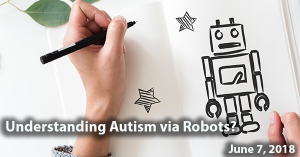Check out other stories from the Latest News
Reactions to Robot Could Reveal Internal Patterns in Autism
By Chelsea Toledo, M.A. on June 7, 2018

Background: Biologically speaking, a genotype is an organism’s underlying genetic identity, made up of inherited factors. A phenotype refers to observable characteristics such as social behavior. An intermediate term endophenotype is used to define stable, measurable traits, observed in multiple individuals, with a clear link to underlying genetic makeup.
What’s New: A new study assessed whether artificial intelligence could help reveal endophenotypes of individuals with Autism Spectrum Disorder (ASD). The researchers leveraged a female android robot, known as ACTROID-F, to interact with a total of 46 individuals representing four groups – adolescents (ages 13-17) with ASD, typically developing adolescents, young children (ages 1-5) with ASD, and typically developing young children. The robot was programed to smile, nod, move her eyebrows, and demonstrate other evidence of humaneness while interacting with the participants as they completed various tasks. The researchers administered a questionnaire to the adolescent participants and to the parents of the young children, measuring the degree to which the participants felt that the android displayed humaneness (i.e., whether their impression of her was natural, positive, competent, kind, conscious, human-like, responsible, nice, friendly, intelligent, and biological). They found that scores varied significantly between the participants with ASD and their typically developing peers.
Why it’s important: This study suggests that artificial intelligence could reveal an endophenotype for people with ASD. Further research could provide more information about the underlying genetic causes for these patterned differences.
Help me understand :
| Source(s) : |
| Tweet |

